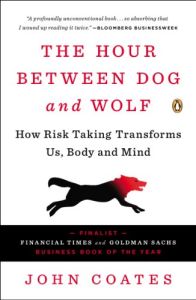Join getAbstract to access the summary!

Join getAbstract to access the summary!
John Coates
The Hour Between Dog and Wolf
How Risk Taking Transforms Us, Body and Mind
Penguin Press, 2013
What's inside?
Fascinating study shows how the mind-body connection can drive a roller-coaster financial market.
Recommendation
Wall Street trader turned Cambridge neuroscientist John Coates is the first to research the physiology, as opposed to the psychology, of trading and risk taking. He does so with an insider’s familiarity. To communicate the vividness of his own experiences in the markets, Coates tells a fictionalized account of a group of traders caught between up-and-down extremes of bubble and crash. He illuminates these histories by explaining how a broad array of scientific disciplines can help explain trading activity. He blends biology, behavioral economics, neuroscience, medicine, sports physiology, and other disciplines to demystify economic activity in clear, even poetic prose. getAbstract recommends his work to those interested in understanding financial markets, mind-body interactions or themselves.
Summary
About the Author
John Coates is a former University of Cambridge senior research fellow in neuroscience and finance. He has traded derivatives for Goldman Sachs and run a trading desk for Deutsche Bank in New York. He now runs Dewline Research, which provides wearable technology to companies and sports teams.
















Comment on this summary
"Unfortunately, our contract with the publisher of this book does not allow us to distribute the summary in your country. This is a rare occurrence and we hope to have additional regional distribution rights in the future. We apologize for the inconvenience. Please feel free to download any other title."
This is the most dangerous kind of sanction against knowledge and wisdom.